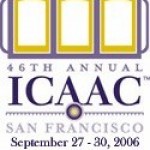A growing number of HIV-positive people who have never taken HIV medications appear to have virus mutations that can cause drug resistance to available treatment options. The new data, involving a review of blood samples collected from people enrolling in GlaxoSmithKline (GSK)-sponsored HIV treatment studies between 2000 and 2005, indicate that the sharpest increase has been in the prevalence of key mutations conferring resistance to non-nucleoside reverse transcriptase inhibitors (NNRTIs).
While mutations in HIV’s genetic structure resulting in drug resistance can happen as a result of the virus’s high error-prone reproduction rate before treatment is started, most experts believe that the increasing rate of these mutations is the result of drug-resistant virus being transmitted among people.
The new data, reported by GSK researchers on Thursday at the 46th Interscience Conference on Antimicrobial Agents and Chemotherapy (ICAAC) in San Francisco, involved 2,035 HIV-positive people beginning treatment for the first time in one of several GSK studies being conducted in the United States between 2000 and 2005. Upon entering the studies, all patients had blood samples available for genotypic drug-resistance testing. Mutations found in the samples were compared against two established lists of drug-resistance mutations, maintained by the International AIDS Society-USA and the Stanford HIV Drug Resistance database.
Looking at all patients enrolled in these studies between 2000 and 2005, 11% had evidence of at least one key mutation in their HIV’s reverse transcriptase gene and/or protease gene known to decrease the activity of available drugs in those classes. Of particular concern was the trend in the percentage of treatment-naïve patients with at least one key mutation associated with drug resistance during those five years. Among the 251 patients enrolling in GSK studies in 2000, 5% to 6% had evidence of pre-treatment drug resistance. By 2005, approximately 17% to 18% of the 240 patients starting therapy for the first time in these studies had at least one major drug-resistance HIV mutation.
The prevalence of mutations conferring resistance to protease inhibitors (PIs) has remained relatively low and stable since 2000; 5% or fewer patients entering the GSK studies had PI-related mutations at any time point through 2005. The prevalence of mutations known to cause resistance to nucleoside reverse transcriptase inhibitors (NRTIs) has increased moderately, from approximately 4% to 5% of patients in 2000 to approximately 7% to 8% in 2005.
Most alarming was the increased prevalence of key mutations known to cause high-level resistance to the NNRTIs. In 2000, approximately 2% of patients entering GSK studies had evidence of these mutations. By 2005, approximately 10% to 11% were documented to have NNRTI-associated mutations.
Of interest, black men entering GSK studies were significantly less likely to have HIV mutations associated with drug resistance. Between 2000 and 2005, 12% of white and Hispanic patients had at least one resistance-associated mutation at study entry, compared to 8% of black patients. No reason for this discrepancy was provided by the study authors.
Encouragingly, evidence of HIV resistance to drugs in two or more classes of the available oral medications is still rare among treatment-naive patients. Between 2000 and 2005, the rate of resistance to medications in more than one class of drugs remained less than 2%.
The authors also noted that pre-treatment drug-resistance mutations were somewhat more likely to be seen in patients entering the studies with high viral loads. Among those with pre-treatment viral loads less than 100,000, 10% had evidence of drug-resistance mutations. Among those with pre-treatment viral loads of 100,000 or greater, 12% had evidence of drug-resistance mutations.
These results, the authors pointed out, underscore the importance of conducting genotypic resistance testing in HIV-positive people before they begin treatment. The U.S. Department of Health’s Guidelines for the Use of Antiretroviral Agents in HIV-1-Infected Adults and Adolescents were revised in May 2006 to reflect this expert opinion.
“For many reasons,” the authors concluded, “genotypic resistance testing may not be possible for every HIV-infected individual. However, given that the transmission of NNRTI mutations appears to be rising, and that NNRTI resistance mutations tend to confer broad cross resistance among the NNRTI class, use of [pre-treatment] resistance testing should be carefully considered.”
Source:
Ross L, Florence A, Wine B, et al. Factors associated with HIV-1 mutations linked to drug resistance in antiretroviral therapy (ART) naive HIV-infected individuals in the United States (US) from 2000-2005 (PREPARE study) [Abstract H-0993]. 46th Interscience Conference on Antimicrobial Agents and Chemotherapy, San Francisco, 2006.
ICAAC: More Drug-Resistant HIV?




Comments
Comments